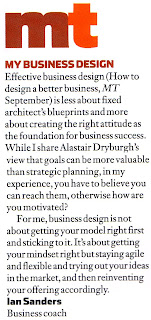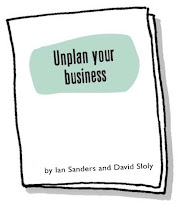Nina Kaufman is an award-winning New York City attorney, edutainer and author. She has just written a piece 'The Light Business Plan' that appears on WomenEntreprenuer.com and FoxBusiness.com. I have pasted the article below (article copyright remains Nina Kaufman).
I was all set to write a column on business planning, employing Gen. Dwight D. Eisenhower's overused quote, "If you fail to plan, you plan to fail." But then I read Ian Sanders and David Sloly's booklet,"Unplan Your Business," which gave me a very different perspective. While Eisenhower wasn't wrong, businesses has changed radically over the past five years . . . so the standards of business planning that many of us grew up with may no longer apply. In particular, the days of the detailed three-, five- and 10-year plan may well have gone the way of the Betamax. With the rapid pace of change, who can predict how things will look in one year, much less five? And the newly self-employed (a.k.a. the recently unemployed) may not have the luxury of time to engage in business plan navel-gazing.
Sanders and Sloly don't advocate no planning--they simply raise the valid point that too much planning, evaluating and cogitating can lead to what's known as "analysis paralysis." They suggest that many entrepreneurs--especially those in service-based businesses that are not capital-intensive--will go further with plans that "are short, sweet, and clear; plans that inspire, excite and motivate you to fill them." Why? Because ultimately, your business will go nowhere with just a plan. You have to take action to implement the plan. And if you have filled the plan with too many impossible details, one of two things will happen: - 1) You will lose the passion to bring that plan to fruition.
- 2) Or, you will lose the flexibility you need to respond to market conditions.
Ask most successful business owners, and they will tell you that "carefully plotted linear routes" (Sanders' and Sloly's phrase) are not the way they achieved success.
So if an agonizingly detailed business plan isn't necessary, what is?
Your business plan needs to outline two objectives:
- 1) How you will achieve growth
- 2) How you will manage your risks
Growth is the easy and fun part. That's describing your ideal target market, how you will attract them and what makes your product or service unique.
Risk management is the not-so-fun part. It's the part that acknowledges that you do not have unlimited financial resources to bail you out of trouble (or avoid bankruptcy). How will you bootstrap your business with the resources you have? The key is not to run out of money before your business has had an opportunity to become profitable. You'll want to make a note of:
- - Startup expenses. What are your initial (and, usually, one-time) costs for business filings, equipment, website launch and related marketing, and professional fees?
- - Fixed expenses. What bills will come in every month, regardless of how much business you're doing? For example: cell phone bills, rent, insurance, internet access, other hosting or online membership fees.BestSmallBizHelp.com has a good video that explains this if you're a little fuzzy on the topic.
- - Variable expenses. Do you have any expenses that change depending on the quantity of business? For example: additional independent contractor expenses to staff an unusually large project, or inventory, packaging and shipping of product orders.
Gathering this financial data isn't exactly sexy--but then, neither is going bankrupt. What is sexy is power. That's the power that comes from knowing your true financial situation. And with that knowledge, you can manage your legal risks. Those are the risks that come from not paying each vendor, employee, and credit institution you use for your business in a timely manner.
So sure, let loose and "unplan" . . . but be a little tight when it comes to your numbers. In the end, your business needs to generate enough money for you to live on. And you can't know whether you're meeting the mark if you don't measure it.







